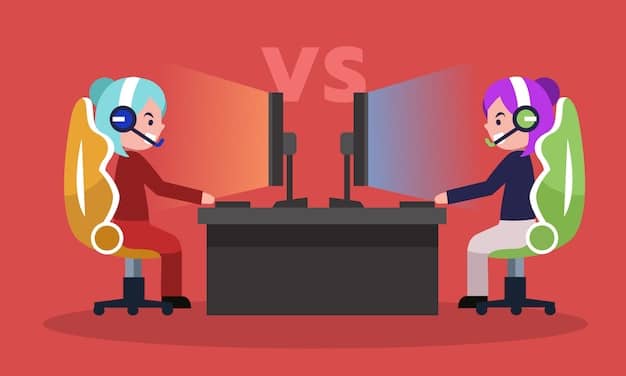Metaverse Gaming: Immersive Experiences & New Worlds Explored

The Metaverse and Gaming are converging to create immersive experiences and new worlds, offering gamers unprecedented levels of interaction, customization, and engagement.
The convergence of the metaverse and gaming is not just a trend; it’s a revolution. The Metaverse and Gaming: Exploring New Worlds and Immersive Experiences are redefining how we play, interact, and even perceive reality.
What is the Metaverse and How Does it Relate to Gaming?
The metaverse, a term once confined to science fiction, is rapidly becoming a tangible reality. But what exactly is it, and how does it intertwine with the world of gaming?
In essence, the metaverse is a persistent, shared, 3D virtual world, or collection of worlds, that is interactive, immersive, and collaborative. It’s a digital realm where people can socialize, work, play, and transact, often using avatars to represent themselves.
Key Aspects of the Metaverse:
- Persistence: The metaverse exists continuously, regardless of whether individual users are logged in.
- Interactivity: Users can interact with each other and the environment in real-time.
- Immersion: The experience can be highly immersive, blending the physical and digital worlds through technologies like VR and AR.
Gaming is a natural fit for the metaverse. Games already provide immersive, interactive experiences, and many incorporate virtual economies and social elements. Integrating games into the metaverse extends these capabilities, creating richer and more persistent gaming experiences.

The relationship between the metaverse and gaming is symbiotic, with each enhancing the other. The metaverse provides a platform for games to evolve beyond traditional boundaries, while games drive innovation and engagement within the metaverse.
In conclusion, the metaverse is an evolving digital frontier that is rapidly changing the landscape of gaming by creating persistent, shared, and immersive environments where players can interact, create, and compete in unprecedented ways.
The Rise of Metaverse Games: Examples and Features
As the metaverse continues to develop, a new breed of games is emerging, designed specifically for these virtual worlds. These games go beyond traditional gaming experiences, offering unique features and opportunities.
Several metaverse games have already gained significant traction, showcasing the potential of this new gaming paradigm.
Popular Metaverse Games:
- Decentraland: A virtual world where users can buy, build, and explore virtual land. Gaming experiences are integrated into the land ownership and exploration aspects.
- The Sandbox: A user-generated content platform where players can create, share, and monetize their own voxel-based assets and gaming experiences.
- Axie Infinity: A blockchain-based game where players collect, breed, and battle digital creatures called Axies. It features a play-to-earn model, allowing players to earn real money through gameplay.
These games share several common features that distinguish them from traditional games. They often incorporate blockchain technology, NFTs, and virtual economies, enabling players to own and trade in-game assets. They also emphasize user-generated content, allowing players to shape the game world and create their own experiences.
In conclusion, metaverse games are pushing the boundaries of what’s possible in gaming, offering players new ways to interact, create, and earn in virtual worlds. These games leverage blockchain technology, user-generated content, and virtual economies to provide immersive and rewarding experiences.
Immersive Technologies Driving Metaverse Gaming
The immersive nature of metaverse gaming is largely driven by advancements in various technologies. These technologies work together to create experiences that blur the lines between the physical and digital worlds.
Key technologies powering metaverse gaming include:
VR, AR, and XR:
- Virtual Reality (VR): Provides a fully immersive experience, transporting players to virtual environments. VR headsets track head and hand movements, allowing for realistic interactions.
- Augmented Reality (AR): Overlays digital elements onto the real world, enhancing the gaming experience without fully replacing the player’s surroundings. AR games often use smartphone cameras to track the environment.
- Extended Reality (XR): An umbrella term encompassing VR, AR, and other emerging reality technologies. XR aims to create seamless and intuitive interactions between humans and machines.
Beyond visual immersion, haptic technology plays a crucial role. Haptic devices provide tactile feedback, allowing players to feel virtual objects and textures. This adds another layer of realism to the gaming experience.

These technologies are rapidly evolving, with advancements in display resolution, tracking accuracy, and processing power. As these technologies become more affordable and accessible, they will further democratize metaverse gaming, allowing more people to participate in these immersive experiences.
In summary, virtual reality, augmented reality, extended reality, and haptic technology are key drivers of metaverse gaming, creating immersive experiences that engage multiple senses and blur the lines between the physical and digital worlds.
The Economic Impact of Metaverse Gaming
Metaverse gaming is not just about entertainment; it also has significant economic implications. The integration of blockchain technology, NFTs, and virtual economies creates new opportunities for players and developers alike.
One of the most notable economic trends in metaverse gaming is the rise of play-to-earn models. These models allow players to earn cryptocurrency or NFTs by participating in games. These rewards can then be traded or sold on marketplaces for real money.
Play-to-Earn and Virtual Economies:
- NFTs: Unique digital assets that represent ownership of in-game items, characters, or virtual land. NFTs can be traded on blockchain marketplaces, creating a new revenue stream for players and developers.
- Virtual Land: Plots of digital land within metaverse games that can be bought, sold, and developed. Virtual land ownership allows players to create their own experiences and monetize their creations.
- Cryptocurrencies: Used as the primary currency within metaverse games. Players can earn cryptocurrencies through gameplay and use them to purchase in-game items or services.
Metaverse gaming also fosters new economic ecosystems. Developers can create and sell in-game assets, while players can offer services such as tutoring, mentoring, or content creation. These activities contribute to a thriving virtual economy.
In conclusion, metaverse gaming is transforming the economics of gaming by creating new opportunities for players and developers to earn and transact in virtual worlds. Play-to-earn models, NFTs, virtual land, and cryptocurrencies are key components of this emerging economic landscape.
Challenges and Opportunities in Metaverse Gaming
While metaverse gaming holds immense promise, it also faces several challenges. Addressing these challenges is crucial for the long-term success and wider adoption of metaverse gaming.
Some of the key challenges include:
Accessibility and Scalability:
- Accessibility: VR headsets and other immersive technologies can be expensive, limiting access to metaverse gaming for some people.
- Scalability: Metaverse platforms need to be able to handle a large number of concurrent users without sacrificing performance or stability.
- Interoperability: The lack of interoperability between different metaverse platforms makes it difficult for users to move their assets and identities across virtual worlds.
Despite these challenges, metaverse gaming also presents numerous opportunities. These include:
- Innovation: Metaverse gaming encourages experimentation and innovation, leading to new gaming genres and experiences.
- Social Connection: Metaverse games can foster social connections and communities, providing opportunities for players to interact and collaborate.
- Education and Training: Metaverse platforms can be used for educational and training purposes, providing immersive simulations and interactive learning environments.
Overcoming these challenges and capitalizing on these opportunities will require collaboration between developers, policymakers, and the gaming community.
In summary, metaverse gaming faces challenges related to accessibility, scalability, and interoperability but also offers opportunities for innovation, social connection, and education. Addressing these challenges and leveraging these opportunities will shape the future of metaverse gaming.
The Future of Gaming in the Metaverse
The metaverse is poised to transform the gaming industry in profound ways. As technology continues to advance and metaverse platforms mature, we can expect even more immersive, interactive, and social gaming experiences.
Looking ahead, several trends are likely to shape the future of gaming in the metaverse:
Emerging Trends:
- AI Integration: Artificial intelligence will play a larger role in creating dynamic and personalized gaming experiences. AI-powered characters and environments will adapt to player behavior, making games more engaging and challenging.
- Cross-Platform Experiences: Metaverse platforms will become more interoperable, allowing players to move their assets and identities seamlessly across different virtual worlds.
- Decentralized Governance: Metaverse communities will have more control over the development and governance of their virtual worlds, fostering a sense of ownership and participation.
The potential applications of metaverse gaming extend far beyond entertainment. Metaverse platforms can be used for virtual tourism, remote collaboration, and even therapy and rehabilitation.
In conclusion, the future of gaming in the metaverse is bright, driven by technological advancements, emerging trends, and a growing ecosystem of developers, players, and creators. The metaverse will redefine how we play, interact, and experience games in the years to come.
| Key Element | Brief Description |
|---|---|
| 🌐 Metaverse Gaming | Immersive gaming experiences in virtual worlds. |
| 🎮 Play-to-Earn | Earning rewards through gameplay. |
| ✨ NFTs | Unique digital assets traded in-game. |
| 👓 VR/AR | Technologies enhancing immersion. |
Frequently Asked Questions
▼
The metaverse is a persistent, shared, 3D virtual world, or collection of worlds, that is interactive, immersive, and collaborative. It’s a digital realm where people can socialize and play.
▼
Gaming is a natural fit for the metaverse, providing immersive, interactive experiences. Many games incorporate virtual economies and social elements. This integration extends these capabilities and enhances experiences.
▼
NFTs are unique digital assets that represent ownership of in-game items. They can be traded on blockchain marketplaces, creating new revenue streams for developers and players within the metaverse.
▼
The main challenges of metaverse gaming are accessibility, scalability, and interoperability. High costs can limit accessibility, while a lack of interoperability affects movement of assets between worlds.
▼
Play-to-earn models allow players to earn cryptocurrency or NFTs by actively participating in the game. These assets can be traded on marketplaces for real money, creating an incentive to play.
Conclusion
In conclusion, the metaverse and gaming are converging to create groundbreaking experiences that offer unprecedented interaction, customization, and monetization opportunities. While challenges remain, the potential for innovation and transformation in how we engage with virtual worlds is immense, promising a future where gaming is more immersive, social, and economically rewarding.





